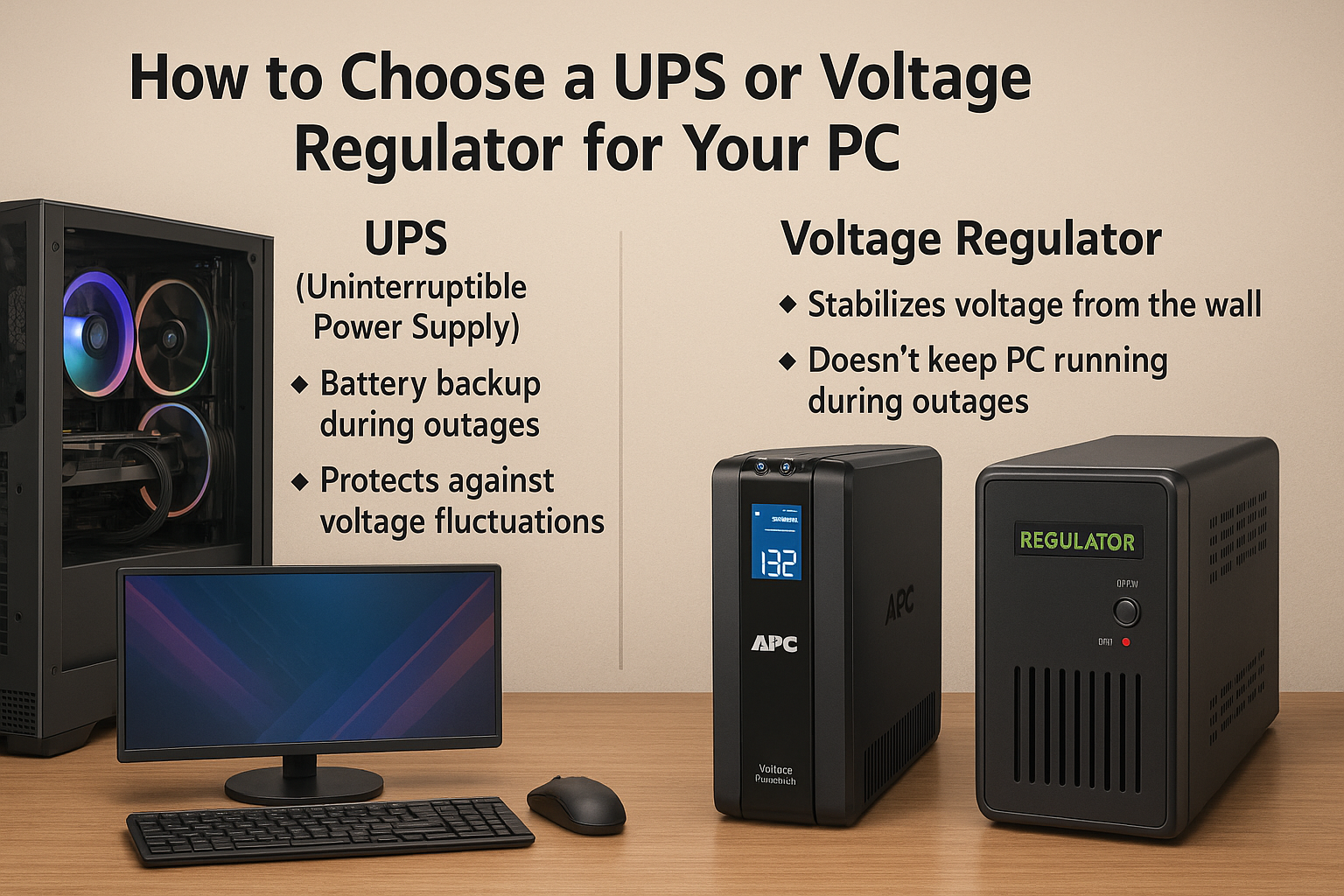When building a reliable PC setup—especially one used for work, gaming, or content creation—it’s easy to forget about power protection. Power outages, voltage drops, and surges can damage components or cause data loss. That’s where a UPS (Uninterruptible Power Supply) or a voltage regulator comes in.
In this guide, you’ll learn the difference between these two devices, when to use each, and how to choose the best one to protect your PC investment.
What Is a UPS?
A UPS (Uninterruptible Power Supply) is a device that provides temporary battery power during an electrical outage. It also conditions the power to protect against:
- Voltage fluctuations
- Spikes and surges
- Brownouts (low voltage events)
A UPS gives you time to save your work and shut down safely. Some models can even keep your system running for 10–30+ minutes depending on the load.
What Is a Voltage Regulator?
A voltage regulator, also known as an automatic voltage regulator (AVR) or line conditioner, doesn’t have a battery. Its main job is to stabilize the voltage from your wall outlet:
- Prevents low or high voltage from reaching your PC
- Helps extend hardware lifespan
- Does not keep your PC running during a blackout
It’s a cheaper option for basic power protection but lacks the full capabilities of a UPS.
UPS vs Voltage Regulator: What’s the Difference?
| Feature | UPS | Voltage Regulator (AVR) |
|---|---|---|
| Battery Backup | Yes | No |
| Surge Protection | Yes | Yes |
| Voltage Stabilization | Yes (in most models) | Yes |
| Keeps PC Running | Yes (short-term) | No |
| Price | Higher | Lower |
| Ideal For | Critical systems, gaming PCs | Basic desktops, printers |
In short:
- Use a UPS for critical machines that need to stay online during outages.
- Use a voltage regulator for basic protection in areas with unstable voltage but fewer blackouts.
Why You Might Need One
Power instability can cause:
- Sudden shutdowns (leading to file corruption)
- Burned-out power supplies
- Crashed hard drives or SSDs
- Shortened component lifespan
If you:
- Live in an area with frequent outages or brownouts
- Work with important files or creative projects
- Use an expensive custom PC setup
- Rely on your PC for income or business
…you should absolutely invest in a UPS or voltage regulator.
Types of UPS Systems
There are three main categories:
1. Standby UPS (Offline UPS)
- Switches to battery when it detects a power failure
- Slight delay (few milliseconds)
- Ideal for home users, small offices
2. Line-Interactive UPS
- Actively regulates voltage via AVR
- Switches faster to battery (more reliable)
- Great for gaming PCs and workstations
3. Online UPS (Double Conversion)
- Converts AC to DC and back to AC continuously
- No switching delay
- Ideal for servers, critical infrastructure
- Most expensive
For most users, a line-interactive UPS offers the best balance of protection and price.
How to Choose the Right UPS (Step-by-Step)
Step 1: Determine Your Power Needs
UPS capacity is measured in VA (volt-amps) and watts. Here’s a rough guideline:
| PC Type | Recommended UPS Size |
|---|---|
| Basic desktop | 600–800 VA (360–500W) |
| Gaming PC + monitor | 1000–1500 VA (600–900W) |
| Workstation or multi-GPU | 1500–2000 VA (900–1300W) |
Use an online UPS calculator (e.g., from APC or CyberPower) for more accuracy.
Tip: Always add 20% buffer above your total power consumption.
Step 2: Consider Runtime
Most consumer UPS models offer:
- 5–15 minutes of backup power under full load
- Enough time to save work and shut down properly
If you need more runtime (e.g., for a NAS or server), look for:
- Extended runtime models
- Or connect external battery packs (if supported)
Step 3: Look at the Outlets
A typical UPS will include:
- Battery backup + surge protection outlets (usually 4–6)
- Surge-only outlets (for non-critical devices)
Make sure there are enough backup outlets for:
- PC
- Monitor
- Router/modem (to keep internet active)
- External drives (if in use)
Step 4: Choose the Right Features
Look for these features:
- LCD screen (shows power draw, battery level)
- USB or serial connection for auto shutdown
- User-replaceable batteries
- Audible alarms (for outages or overloads)
- Energy-saving or ECO mode
Step 5: Choose a Trusted Brand
Reliable UPS manufacturers:
- APC by Schneider Electric
- CyberPower
- Eaton
- Tripp Lite
Avoid generic or no-name brands, which may not deliver promised runtime or surge protection.
How Long Do UPS Batteries Last?
UPS batteries typically last 3 to 5 years. After that, they may:
- Hold less charge
- Trigger warning beeps
- Fail to power devices during an outage
Most models allow battery replacement, making them a long-term investment.
Do You Need a Voltage Regulator If You Already Have a UPS?
If your UPS includes AVR (automatic voltage regulation)—and most line-interactive and online UPS models do—you don’t need a separate regulator.
However, if you’re using a standby UPS without AVR or want added protection for non-battery devices (like printers or routers), you can pair it with a voltage regulator.
Final Thoughts: Don’t Leave Your PC Unprotected
Your PC is full of expensive, sensitive components—and likely important files too. While a UPS or voltage regulator won’t boost your frame rates or load times, it could save your entire system from corruption, damage, or data loss.
If you value stability, productivity, and peace of mind, power protection is a smart investment.
Choose based on your actual power needs, local power conditions, and the critical nature of your PC. Whether you’re a gamer, freelancer, or remote worker, a good UPS can be the silent hero of your setup.
